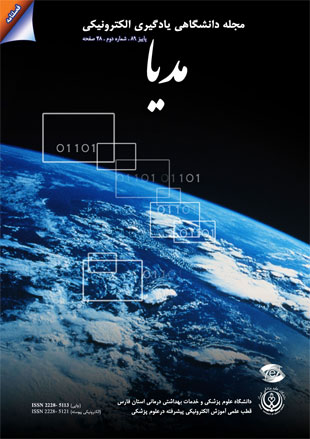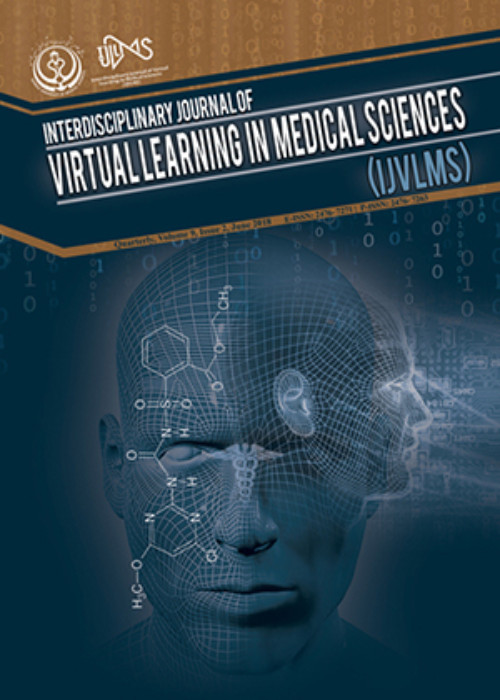فهرست مطالب

Interdisciplinary Journal of Virtual Learning in Medical Sciences
Volume:1 Issue: 2, 2010
- تاریخ انتشار: 1389/09/15
- تعداد عناوین: 7
-
صفحه 2از جمله عوامل اصلی در زمینه پیاده سازی آموزش مجازی در دانشگاه ها اساتید گروه های آموزشی هستند. با این وجود بسیاری از مطالعات، مقاومت اساتید در مقابل پذیرش فناوری های آموزشی جدید را به عنوان مانع و مشکلی اساسی برای رشد برنامه های آموزش مجازی گزارش کرده اند. اساتید اغلب نگرانی ها و مشکلاتی را در جهت شرکت در آموزش مجازی – از قبیل فقدان زمان آزاد، فقدان ارائه حمایت لازم و ارزشگذاری عملی به تلاش خود از سوی موسسه و فقدان کارآموزی بیان می کنند. با این وجود فهرست عوامل بازدارنده مشارکت اساتید در آموزش برخط بسیار طولانی بوده و رفع هر یک از این عوامل نیازمند اتخاذ راهکارهایی متناسب با فضای موسسات آموزشی است. بنابراین محقق برای ثبت عوامل مختلفی که در تحقیقات در این زمینه یافت می شوند آن ها را در سه گروه عمده شامل بازدارنده های شخصی (مرتبط با ویژگی های فردی و عادات رفتاری اساتید) بازدارنده های نگرشی (مرتبط با نگرش اساتید به ویژگی های ذاتی محیط یادگیری در دوره های آموزش مجازی) و بازدارنده های زمینه ای (مرتبط با عدم ارائه حمایت های فنی و سازمانی لازم از سوی موسسه برگزارکننده دوره ها به اساتید) تقسیم بندی نموده و به ارائه راهکارهایی مناسب در جهت غلبه بر این مشکلات می پردازد.
کلیدواژگان: آموزش مجازی، مشارکت اساتید، بازدارنده های شخصی، بازدارنده های نگرشی، بازدارنده های زمینه ای -
صفحه 10مقدمهامروزه تکامل تفکر انتقادی بعنوان هدف نهایی در آموزش علوم پزشکی محسوب می شود. این مطالعه به منظور بررسی وضعیت تفکر انتقادی در دانشجویان دانشگاه علوم پزشکی بوشهر صورت گرفت.روش هادر مطالعهای توصیفی مقایسهای، سطح مهارتهای تفکر انتقادی در 159 دانشجوی پزشکی، پرستاری و مامایی دانشگاه علوم پزشکی بوشهر در سال 1388 مورد بررسی قرار گرفت. ابزار مورد استفاده آزمون مهارتهای تفکر انتقادی کالیفرنیای ب، حاوی 34 سوال چند گزینهای بود. داده ها توسط نرم افزار SPSS و با استفاده از آزمونهای تی تست، آنوا، ضریب همبستگی پیرسون و اسپیرمن مورد تجزیه و تحلیل قرار گرفت.نتایجمیانگین نمره کل تفکر انتقادی دانشجویان 78/2 ± 37/11 بود. اختلاف آماری معنی داری بین میانگین نمرات دانشجویان پزشکی، پرستاری و مامایی دیده نشد. علی رغم اینکه نمرات از ترم اول به ترم آخر سیر صعودی داشت ولی این اختلاف از نظر آماری معنی دار نبود. بین سن و سابقه کار بالینی با نمرات تفکر انتقادی همبستگی مثبت دیده شد.نتیجه گیرییافته ها نشان می دهند که میانگین نمرات تفکر انتقادی دانشجویان دانشگاه علوم پزشکی بوشهر مشابه سایر دانشگاه های کشور می باشد، ولی در مقایسه با نتایج سایر کشورها از میانگین کمتری برخوردار است و این نشان می دهد که برنامه های آموزشی موجود نیاز به بازنگری دارند.
کلیدواژگان: تفکر انتقادی، دانشجویان پرستاری، دانشجویان پزشکی، دانشجویان مامایی، مهارت -
صفحه 17مقدمه
افزایش و بهبود مهارت های تفکر انتقادی دانشجویان در شرایط رشد فزاینده دانش بشر، اهمیت توجه به پرورش مهارت های تفکر دانشجویان را روشن نموده است. در این راستا، استفاده از راهبرد آموزشی بازاندیشی، راه کاری است که توسط پژوهشگران و دست اندرکاران برنامه های آموزشی برای پرورش تفکر توصیه شده است. پژوهش حاضر، برای آزمودن تاثیر بازاندیشی بر مهارت های تفکر انتقادی دانشجویان پرستاری دانشکده پرستاری و مامایی شهرستان شیراز انجام شده است.
روش هاچهل و دو نفر از دانشجویان سال چهارم پرستاری دانشکده پرستاری و مامایی شهرستان شیراز داوطلبانه در این پژوهش شرکت نمودند. این افراد پس از شرکت در یک جلسه توجیهی در آزمون مهارت های تفکر انتقادی شرکت نمودند. سپس به دو گروه 21 نفری آزمون و شاهد تقسم شدند. گروه شاهد در برنامه های معمول بالینی تنظیم شده و گروه آزمون، علاوه بر شرکت در برنامه های معمول بالینی، در برنامه مداخله این پژوهش نیز شرکت نمودند تا آمادگی های لازم را برای انجام بازاندیشی به دست آورند و پس از آن به مدت دوازده هفته، به بازاندیشی بر تجارب بالینی و مراقبتی پرداختند. در پایان برنامه بالینی، هر دو گروه مجددا در آزمون مهارت های تفکر انتقادی شرکت کردند. نتایج به دست آمده از این آزمون، مبنای تحلیل آماری بود و برای تحلیل داده ها از آزمون تی زوج و تی مستقل استفاده شد.
نتایجنتایج پژوهش موید تاثیر بازاندیشی بر پنج مهارت تفکر انتقادی دانشجویان و نیز نمره کل آزمون مهارت های تفکر انتقادی بود. یافته ها تفاوت دانشجویان دو گروه را از نظر کسب مهارت های تفکر انتقادی در طول برنامه مورد تایید قرار داد.
بحث: با توجه به اینکه آزمون مهارت های تفکر انتقادی کالیفرنیا یک آزمون عمومی برای اندازه گیری مهارت های تفکر انتقادی است، تغییر به دست آمده در نتیجه یک روش آموزشی یافته ارزشمندی است که لزوم استفاده از راهبرد بازاندیشی را در برنامه های آموزشی تصریح می نماید.کلیدواژگان: مهارت های تفکر انتقادی، بازاندیشی، آموزش بالینی، یادگیری -
صفحه 24در جهان امروز، آموزش کلید رشد و توسعه کشورها به شمار می آید. کشورهایی که با برنامه ریزی و سرمایه گذاری مناسب، به استانداردسازی شاخص های رشد و توسعه در آموزش همت گمارده اند رشد و توسعه اقتصادی و اجتماعی را نیز از آن خود ساخته اند. بیش از صد سال است که آموزش از دور به عنوان شیوه ای پویا برای ارائه دوره های تحصیلی به دانش آموزان و دانشجویانی که قادر به شرکت در کلاس های سنتی در محیط مدرسه و دانشگاه نیستند خدمت کرده است. روش های ارائه ی آموزش از دور به عنوان روشی اساسی در کاهش موانع دسترسی به فرصت های آموزشی مورد توجه قرارگرفته است. در سال های اخیر با پیشرفت فناوری اطلاعات و ارتباطات، افزایش چشمگیری در استفاده از آموزش از دور در جهان بوجود آمده است. این طریق از ارائه طبیعت جمعیت دانش آموزی را نیز تغییر داده است. آموزش از دور به طور فزاینده ای در حال تبدیل شدن به شکلی پذیرفته از یادگیری است. کشورهایی که نکات قوت این نوع آموزش را دریافته اند از این شیوه آموزش در رشد و توسعه بهره جسته اند؛ چین یکی از این کشورهاست. در این مقاله سعی شده است تاریخچه، ضرورت، اهداف، انواع و آینده آموزش از دور در چین توصیف شود.
کلیدواژگان: آموزش از دور، چین، توسعه -
صفحه 32در دنیای پیرامون افرادی که به نحوی با آموزشهای الکترونیکی سروکار دارند، تنوع فناوری و ابزارهای مرتبط با آن روز به روز پیچیدهتر می شود. شناسایی و طبقه بندی این ابزارها از یک طرف و انتخاب یک ابزار مناسب، بر اساس هدفی که یک سازمان یا یک شخص در به کارگیری این ابزار دارد از طرف دیگر، اهمیت این مطالعه را نشان میدهد.
در این مطالعه مروری ابتدا ابزارهای تولید محتوای الکترونیکی تعریف و تقسیمبندی شده سپس هر یک با توجه به کاربرد آن معرفی شده اند.
کلیدواژگان: ابزارهای تالیف دوره، ابزارهای یادگیری الکترونیکی، فناوری های یادگیری الکترونیکی -
صفحه 39
-
Page 2Currently, many universities all over the world invest in e-learning implementation. One of most important groups influencing this work are faculty members. However, plenty of studies reported faculty resistant to adopt new technologies as a basic challenge against developing e-learning program. According to these studies, faculty remarked broad listing of inhibitor factors- such as lack of time, lack of institutional support, lack of scholarly respect in the areas of promotion and tenure, and lack of training- as their obstacles in participating in e-learning program. However, list of inhibiting factors for faculty participation in distance education is lengthy. Therefore, the researcher proposed one model to record the various factors found within literature studies. According to this model, inhibiting factors are grouped into three categories which included personal (based on habits and individual treatment of faculty) attitudinal (based on faculty attitudes about per se specification of e-learning environment) and contextual (based on institute shortage of supply and institutional support). Upon this categorization, the researcher investigates issues that affect the above notions.Keywords: Virtual instruction, Professors collaboration, Personal inhibitors, Contextual inhibitors, Attitude inhibitors
-
Page 10Abstract:IntroductionToday, the development of critical thinking is considered an expected outcome of graduate studies. This study was designed to determine the critical thinking skills of students of Bushehr University of Medical Sciences.MethodsIn a descriptive comparative study, 159 medical, nursing and midwifery students were investigated in 2009. The California Critical Thinking Test, Form B(CCTST,FB)composed of 34 multiple choice questions was used to assess the critical thinking skills. The data was analyzed by spss software using t-test, ANOVA, spearman, and Pearson correlation coefficient.ResultThe mean and standard deviation of critical thinking scores for medical, nursing and midwifery students were 11.37±2.78,respectively which weren’t significantly different. there were not a significant different between critical thinking skills scores of first and last year’s students. A significant correlation was seen between sex and clinical experience of students and the score of the test.Conclusionthe mean scores of critical thinking skills in this research was similar of scores of other survey in our country but was lower than other country. this means, that the educational program can not promote critical thinking skills in university and revised the curriculum seems necessary.Keywords: critical thinking skills, nursing student, medical student, midwifery
-
Page 17
Introduction. The significance of fostering critical thinking in students has been explicated by the increasing rate of knowledge and information. To assimilate knowledge and to assess the considerable amount of information, students need to develop their thinking skills. Considering reflection as a teaching strategy and one of the most effective ways for fostering thinking, this study was designed to determine the effect of reflection on thinking skills of nursing students at Tabriz faculty of nursing and midwifery. Methods. 42 nursing students participated in this study voluntarily. After receiving the necessary information regarding their participation they took California Critical Thinking Skill Test. Then they were divided into 2 equal case and control groups. Both groups had their routine clinical programs, but the interventional program was offered only to the case group. This interventional program consisted of 3 main parts: A 4 day workshop on reflection and 12 weeks reflection on their clinical experiences, concluding dialog journals and writing up logs. At the end of their clinical program, both groups took the same test as pretest. Data were analyzed by paired T-test and T-test.
ResultsResults of the study revealed that reflection has been effective on improving inductive reasoning and total scores of critical thinking skills of students.
ConclusionImproving general critical thinking skills due to a disciplinary specific strategy was a valuable outcome. Regarding this results, reflection is recommended to be infused in our educational program.
Keywords: Critical Thinking Skills, Reflection, Nursing Students -
Page 24In today's world, education is considered as a key factor to development of countries. Countries, which have tried to standardize development indicators in education through appropriate programming and investments, have also devoted social and economic growth to themselves. For more than one hundred years, distance education has been recognized as a helpful and active approach in presenting educational courses to students who are not able to participate in traditional classes in school or university. Approaches for presenting distance education have been taken into consideration as a fundamental process in reducing obstacles to access educational opportunities. In recent years with progress in the information and communication technology, the use of distance education has increased remarkably. This way of presenting has also changed the nature of the student population. Distance education has been increasingly converting to an acceptable form of learning. Countries which have realized the strong points of this type of education have taken advantage of this educational approach in development; China is one of these countries. This article aims to describe the history, necessity, objectives, types and future of distance education in China.Keywords: Distance Education, China, Development
-
Page 32In the world around of people who use e-Learning anyway, technology and the tools related to it become more complex every day. The recognition and classification of these tools on the one hand, and choosing the appropriate tools due to the personal and organizational goals on the other hand show the importance of this review. In this review first, we define and classify the authoring tools, then we introduce all due to use of them.Keywords: Authoring tools, e, Learning tools, e, Learning technologies


